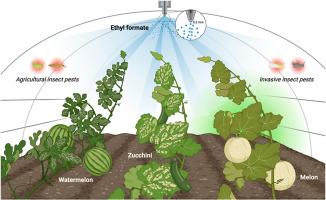甲酸乙酯在西瓜、西葫芦、甜瓜商业大棚害虫治理中的应用
IF 2.5
2区 农林科学
Q1 AGRONOMY
引用次数: 0
摘要
在以前的研究中,甲酸乙酯(EF)熏蒸已被证明是小型温室系统有害生物管理的可行方法,强调需要在商业规模上进一步验证和优化。本研究旨在评价EF熏蒸控制农业害虫的最佳条件,重点关注易感和抗吡虫啉的桃蚜和抗刺草碱的棕榈蓟马,以及在商业温室操作中对烟粉虱和棉蚜等入侵害虫的预防。通过使用0.3 mm细喷嘴和将喷嘴定位在有利于气体均匀分布的位置,优化了温室中EF熏蒸的商业规模应用。该方法对易感、耐吡虫啉的桃蚜和耐spinosad的棕榈蚜均有显著的防治效果。结果表明,甜瓜温室以最小的植物毒性效应为有效的害虫管理提供了最合适的条件。相比之下,西瓜和西葫芦温室表现出植物毒性,这是由于作物对EF的高度敏感性和熏蒸剂分布不均匀。结果表明,处理1 h时EF浓度与植物毒性呈正相关,浓度-时间值与目标害虫死亡率呈正相关。这些结果表明,EF熏蒸在甜瓜温室栽培中具有较高的药效和最小的植物毒性,是一种很有前途的替代传统农药的方法。然而,考虑到季节性害虫动态、植物耐受性以及作物对热胁迫和EF的敏感性,还需要进一步的研究来评估EF熏蒸在不同作物发育阶段和生长季节的应用。本文章由计算机程序翻译,如有差异,请以英文原文为准。

Application of ethyl formate for the management of insect pests in commercial greenhouses cultivating watermelon, zucchini, and melon
Ethyl formate (EF) fumigation has been demonstrated as a feasible approach for pest management in small-scale greenhouse systems in previous studies, underscoring the need for further validation and optimization at the commercial scale. This study aims to evaluate optimal conditions of EF fumigation for controlling agricultural insect pests, focusing on both susceptible and imidacloprid-resistant Myzus persicae and spinosad-resistant Thrips palmi, while also preventing invasive pests such as Bemisia tabaci and Aphis gossypii in commercial greenhouse operations. The commercial-scale application of EF fumigation in the greenhouse was optimized by using a 0.3 mm fine nozzle and positioning spray nozzles at locations that facilitated uniform gas distribution. This approach achieved significant efficacy against susceptible and imidacloprid-resistant M. persicae, as well as spinosad-resistant T. palmi. The findings revealed that melon greenhouses provided the most suitable conditions for effective pest management with minimal phytotoxic effects. In contrast, watermelon and zucchini greenhouses exhibited phytotoxicity, attributed to the crop's heightened sensitivity to EF and uneven fumigant distribution. A positive correlation was identified between EF concentration at 1 h and phytotoxicity, as well as between the concentration-time value and mortality of target pests. These findings suggest that EF fumigation could be a promising alternative to conventional pesticides, demonstrating high efficacy and minimal phytotoxicity in melon greenhouse cultivation. However, further research is required to assess the application of EF fumigation across different crop developmental stages and growing seasons, considering seasonal pest dynamics, plant tolerance, and crop sensitivity to both heat stress and EF.
求助全文
通过发布文献求助,成功后即可免费获取论文全文。
去求助
来源期刊

Crop Protection
农林科学-农艺学
CiteScore
6.10
自引率
3.60%
发文量
200
审稿时长
29 days
期刊介绍:
The Editors of Crop Protection especially welcome papers describing an interdisciplinary approach showing how different control strategies can be integrated into practical pest management programs, covering high and low input agricultural systems worldwide. Crop Protection particularly emphasizes the practical aspects of control in the field and for protected crops, and includes work which may lead in the near future to more effective control. The journal does not duplicate the many existing excellent biological science journals, which deal mainly with the more fundamental aspects of plant pathology, applied zoology and weed science. Crop Protection covers all practical aspects of pest, disease and weed control, including the following topics:
-Abiotic damage-
Agronomic control methods-
Assessment of pest and disease damage-
Molecular methods for the detection and assessment of pests and diseases-
Biological control-
Biorational pesticides-
Control of animal pests of world crops-
Control of diseases of crop plants caused by microorganisms-
Control of weeds and integrated management-
Economic considerations-
Effects of plant growth regulators-
Environmental benefits of reduced pesticide use-
Environmental effects of pesticides-
Epidemiology of pests and diseases in relation to control-
GM Crops, and genetic engineering applications-
Importance and control of postharvest crop losses-
Integrated control-
Interrelationships and compatibility among different control strategies-
Invasive species as they relate to implications for crop protection-
Pesticide application methods-
Pest management-
Phytobiomes for pest and disease control-
Resistance management-
Sampling and monitoring schemes for diseases, nematodes, pests and weeds.
 求助内容:
求助内容: 应助结果提醒方式:
应助结果提醒方式:


